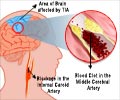According to scientists, spending adolescent years in stroke vulnerable belt increased the risk of getting stroke in adulthood.

Studies have revealed a minor variation on the basis of traditional predisposing risk factors such as high blood pressure and diabetes.
Past studies have shown that people born in the susceptible stroke belt but not living there continue to be in danger of having stroke.
The experts tried to observe how people dwelled in the stroke belt throughout their lives and whether age period had any influence in determining the stroke risk.
The researchers evaluated the data from the Reasons for Geographic and Racial Differences in Stroke (REGARDS), a national random sample of the population residing in the stroke belt. Around 24,544 people in the average age group of 65 years. These people never had any incidence of stroke at the onset of the study. 57 percent of the volunteers were currently living in the vulnerable stroke belt while 43 percent lived in other parts of the country.
The volunteers were traced for about 5.8 years during the entire span of study 615 people had their first stroke.
Those who spent their teenage years in the stroke belt had 17 percent more chances of having a stroke.
Virginia J. Howard, PhD, of the School of Public Health University of Alabama at Birmingham, a member of the American Academy of Neurology and the study author said, "This study suggests that strategies to prevent stroke need to start early in life."
Prof. Howard mentioned, "Many social and behavioral risk factors, such as smoking, are set in place during the teenage years, and teens are more exposed to external influences and gain the knowledge to challenge or reaffirm their childhood habits and lifestyle."
The study was financially aided by the National Institute of Neurological Disorders and Stroke and the National Institute on Aging.
Teen years may be critical in later stroke risk - Science Daily
Source-Medindia















